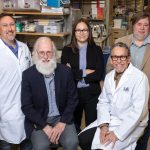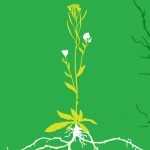Kenta Asahina Flying into the future of technology and innovation
Originally from Chiba, Japan, Associate Professor Kenta Asahina grew up exploring the farmland outside his town with his two brothers in search of insects and plants. Their dad enjoyed taking them to the mountains and national parks, and these experiences inspired Asahina’s interest in the natural world from a young age.
Asahina, who holds the Helen McLoraine Developmental Chair in Neurobiology, now studies how genetics impact behavior in fruit flies, as part of Salk’s Molecular Neurobiology Laboratory. Although tiny flies may seem a far reach from humans, his work consistently demonstrates the many similarities between insects and humans, including our need for social interaction and how our genes may work in similar ways to cause disease.
Inside Salk sat down with Asahina to learn about his path to becoming a scientist, his work and his vision for Salk’s future.
Did you always want to become a scientist?
KA: Actually, no. I didn’t really know what the career of a scientist looked like since all of my close relatives were humanities or art majors. But I was very interested in biology, so I followed my passion to pursue zoology at the University of Tokyo. The university has great biology professors and is known for producing excellent scientists, so I was elated to attend. My senior year, I joined a lab to focus on research and studied the molecular biology of honeybees and their social behavior.
From there, I went to Rockefeller University in New York for my PhD. I had never lived outside of Japan before, but the United States is the center of the world’s research activity. Although I was far from my family in Japan, moving to the US was one of the best decisions of my life because I was exposed to so many diverse perspectives.
Why did you switch your focus to studying fruit flies?
KA: I found that the genetic tools were very limited in the honeybee model. I realized that if I wanted to pursue more rigorous, cutting-edge research then I would need to switch to a model organism that was more readily used, and with more existing technologies. Using the common fruit fly Drosophila melanogaster as a model was a natural choice for me because I was still very interested in studying the behavior of insects. I have an affinity towards insects as these were the kinds of animals I played with as a kid. In my research, one thing I like to do is test how a specific gene and neuron control behavior. So, I was eager to learn about the state-of-the-art neurogenetic techniques available in the fly model.
Why are fruit flies a great model species for studying genes and behavior?
KA: Thanks to a long history of scientists using flies as a genetic model, there are so many powerful genetic resources available to study this animal species. It’s not exaggeration to say we can manipulate virtually any gene or neuron in the fly. In addition, the body of a fruit fly is segmented, and their body movement is limited. Thus, you can use computational analysis to easily quantify their behavior, such as courtship and fighting, with high accuracy. Fruit flies also have a short life span of about four to eight weeks, which is a great advantage when studying aging.
And as a member of the San Diego Nathan Shock Center, a consortium of local research institutions, how are you using fruit flies to study aging?
KA: The goal of the Nathan Shock Center is to better understand aging to advance personalized interventions that could increase the number of years of healthy life (health span). I study how genes and neurons lead to the control of social behavior, but I also recently started looking at how social isolation affects long-term health. I was curious to see how social isolation affected aging and life span. Then the pandemic happened, and my work became especially relevant.
And what did you find about social isolation?
KA: Well, it’s interesting. We examined the effects of social isolation on male versus female flies to see how their behavior differed. Because flies have neurons that are specific to each sex, in the lab we can make a male fly that has a female brain and vice versa. In other words, in flies, we can dissociate the sex of the brain with the sex of the body. That can be useful for understanding the impact either body sex or brain sex has on life span.
We found that our “normal” or fully female flies live longer than males. Interestingly, the females with male brains do not live as long as the normal females. The male-type brain seems to shorten their life span for some reason, and we want to know what is causing this altered life span. One possibility is that male-specific behaviors, such as mating, or behavioral motivations may be energetically costly. The fact that the brain can influence the life span of animals is very interesting.
Does this finding have any relevance in humans?
KA: It will be interesting to see if this kind of life span flexibility that we observed in the fly also occurs in humans. While food, exercise and sleep are all important for a healthy life, experiments in the fly may tell us something about how mental health can impact health and longevity. Statistically, we do know that social isolation is a health risk factor for many conditions. For example, elderly people who are isolated tend to suffer more, which reduces their life and health spans. Thus, it is critical to better understand how social interactions and mental health play a role in longevity. So, animal models, like flies, can be an inspiring way to look at human health.
And what can a fruit fly tell us about human brain disorders?
KA: Obviously, flies are not humans, and some diseases do have specific origins in the human brain. But we can use flies to go down to the molecular level to unravel how genes and cells malfunction, causing the problems that can lead to disease. Once we know which genes are involved, we can study their molecular function and their role in cells and tissues, which often does translate to other animals, including humans. It is worth mentioning that genes that govern our sleep cycles were originally found in flies. These molecules control human wakefulness with exactly the same mechanisms as in flies.
My lab also identified a small fly molecule used for cell-to-cell communications in the brain as a key regulator of aggressive behavior. Surprisingly, this molecule is important for controlling aggression in mice, rats and cats, and there is a study that links aggressive behavioral disorder in humans to the same molecule. The human neuron and the fly neuron may not be the same, but the genes often work in similar ways.
How do genes lead to behavior?
KA: That’s an important question! This is one of the biggest challenges in neuroscience today. We can identify gene function and how that impacts individual neurons, but how that translates to an external behavior is difficult to study. And it begs the question, which is more important—nature or nurture? The answer is both! As a geneticist by training, I cannot overemphasize that genes do not determine your fate.
Even if animals have the same genetic makeup, if you raise them in different environments, then they’re going to act very differently. But genes also have a major impact because if an animal has a particular gene mutation, then it may respond differently to an environmental change than one without the mutation. Thus, genes play a role in how sensitive we may be to a particular environment. For example, even if someone has a genetic mutation making them more susceptible to a certain cancer, there are a lot of lifestyle changes they can make to help live a long, healthy life.
I believe that scientists need to start taking environmental variability into account. In other words, how nature and nurture interact is a critical question moving forward. Doing this will make the research more complicated, but the findings will be more interesting. And with the fly as a model, we are in a great position to carry out these types of experiments.
How will Salk’s Campaign for the Future help with those experimental goals?
KA: Our world is changing quickly, and experiments are getting more complicated and more demanding. Our current technologies limit us from doing the exact experiments we want to do, and we can’t just order new devices because they don’t yet exist. We need to create new technology to answer new questions. The Campaign for the Future is a $500 million philanthropic and scientific campaign that will reimagine Salk’s campus by adding critical laboratory, technology and engineering space to accelerate Salk’s innovative research tackling some of the most challenging problems facing humanity.
The Computational and Engineering Center of Excellence in the planned Joan and Irwin Jacobs Science and Technology Center is designed to allow for collaboration between a team of in-house engineers and Salk scientists. For example, I might draw a sketch of what I need specifically for our experiments, then the engineers would make a prototype, which my lab could test and provide feedback for the engineers to create an even better product. This process would allow us to develop cutting-edge, commercially unavailable devices quickly and efficiently. With the new Center, engineers and biologists will be able to work together to invent new devices to keep Salk’s research ahead of the curve. If we want to make big improvements in human health, then we need answers as soon as possible.
Are you up for the challenge?
Featured Stories
 The Salk Institute and Lustgarten Foundation form strategic pancreatic cancer research partnershipSupported by a $5 million grant, the partnership aims to identify and validate potential targets for new pancreatic cancer drugs. Four participating labs, led by Salk Professors Reuben Shaw, Ronald Evans, Tony Hunter and Assistant Professor Dannielle Engle, will bring their individual areas of complementary expertise to bear on the collaborative goal.
The Salk Institute and Lustgarten Foundation form strategic pancreatic cancer research partnershipSupported by a $5 million grant, the partnership aims to identify and validate potential targets for new pancreatic cancer drugs. Four participating labs, led by Salk Professors Reuben Shaw, Ronald Evans, Tony Hunter and Assistant Professor Dannielle Engle, will bring their individual areas of complementary expertise to bear on the collaborative goal. The weed that changed the worldHow Arabidopsis thaliana became one of the most important tools in science—and how the information the small weed has revealed over decades of research now enables the development of Salk Ideal PlantsTM, a new generation of food crops that are better equipped to both thrive in a changing climate and help mitigate it.
The weed that changed the worldHow Arabidopsis thaliana became one of the most important tools in science—and how the information the small weed has revealed over decades of research now enables the development of Salk Ideal PlantsTM, a new generation of food crops that are better equipped to both thrive in a changing climate and help mitigate it. Courtney Glavis-Bloom — Shining the spotlight on aging to find a cure for Alzheimer’s diseaseSenior Staff Scientist Courtney Glavis-Bloom’s work is driven by her experience caring for her grandparents, who were diagnosed with Alzheimer’s disease when she was in high school. She saw firsthand how dementia robs individuals of their connections to the world—now she studies the brain areas affected in aging in the hope of finding a cure.
Courtney Glavis-Bloom — Shining the spotlight on aging to find a cure for Alzheimer’s diseaseSenior Staff Scientist Courtney Glavis-Bloom’s work is driven by her experience caring for her grandparents, who were diagnosed with Alzheimer’s disease when she was in high school. She saw firsthand how dementia robs individuals of their connections to the world—now she studies the brain areas affected in aging in the hope of finding a cure. Helen McRae — Leveraging the body’s own immune response for more effective cancer therapiesHelen McRae was a graduate student when her cousin was diagnosed with lung cancer and received immunotherapy—an approach that empowers a patient’s own immune system to destroy tumors. McRae saw the promise of this newer treatment, but also how much more research is needed to help it work for more people.
Helen McRae — Leveraging the body’s own immune response for more effective cancer therapiesHelen McRae was a graduate student when her cousin was diagnosed with lung cancer and received immunotherapy—an approach that empowers a patient’s own immune system to destroy tumors. McRae saw the promise of this newer treatment, but also how much more research is needed to help it work for more people. Kenta Asahina – Flying into the future of technology and innovationOriginally from Japan, Associate Professor Kenta Asahina grew up exploring nearby farmlands with his two brothers in search of insects and plants. Their dad enjoyed taking them to the mountains and national parks. These experiences inspired his interest in the natural world, and Asahina now studies how genetics impact fruit fly behavior.
Kenta Asahina – Flying into the future of technology and innovationOriginally from Japan, Associate Professor Kenta Asahina grew up exploring nearby farmlands with his two brothers in search of insects and plants. Their dad enjoyed taking them to the mountains and national parks. These experiences inspired his interest in the natural world, and Asahina now studies how genetics impact fruit fly behavior.




















































